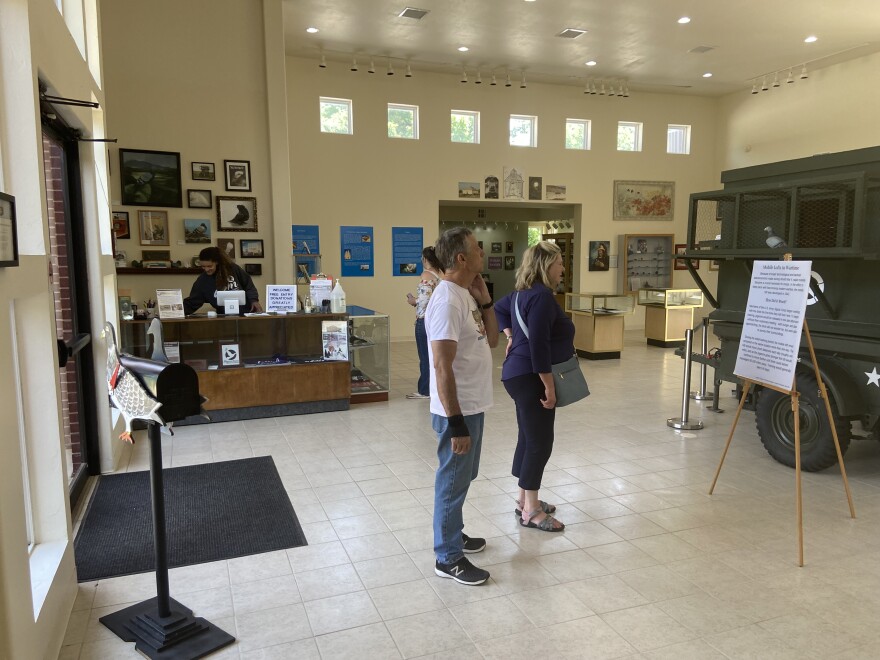I'm Rachel Hopkin, the host and producer of How Curious. This episode is all about The American Pigeon Museum and Library which I visited recently. It's based in Oklahoma City's Adventure District, close to Remington Park. There I met up with its Associate Curator Lauren Gandara. Lauren told me that the Museum was founded in the early 70s and that its purpose is to teach the public about how important pigeons are in history, about the sport of pigeon racing, and about the amazing variety of pigeon breeds.

The original board members chose to base the museum in Oklahoma City because of its central location (How Curious regulars may remember that this was also the case for The Morgan Horse Grand National and Championship). In 2014 , the Museum moved to a brand new and specially designed building which has different wings (no pun intended). In line with the Museum's purpose, one wing is dedicated to fancy pigeons – incredible creatures that look nothing like your typical greyish city pigeons; another is devoted to the sport of pigeon racing; and the third is all about pigeon history through the ages. This is where I began my tour. There I learned that earliest records of pigeons date back to around 3000 BC and the ancient Egyptians. Later, the bird became crucial to Julius Caesar’s empire-building ambitions. They were also used in ancient Greece, not least as a means of sending the results of the early Olympics back to the athletes’ home towns.
The reason for the bird's place in history is because the homing pigeon has an almost preternatural ability to find its way home, even when released hundreds of miles away from its base. Alberto Gandara has been around pigeons all his life and is a longtime volunteer at the museum (and is also Lauren’s husband). I asked him how the bird is able to do this. He that it's still not fully understood but that it is "a combination of the earth’s magnetic field, the sun’s position, and olfactory senses come into play."

During the two World Wars, pigeons were often dropped by parachute over enemy lines so that the soldiers on the ground could use them to send messages back home. According to Alberto, “the enemy knew they were delivering messages and they were shooting at them. And there are famous birds that came home missing legs and eyes and still delivered messages that saved thousands and thousands of lives. Cher Ami was a very famous bird that actually had its foot shot carrying the message and the bird’s tendon held the message on and delivered it."
Alberto showed me around the racing pigeon wing. He was himself introduced to the sport by his father. In pigeon racing, the competing birds are taken to a specific location and released all together. Whichever pigeon arrives home in the quickest time wins. Of course, there’s no finish line per se because each pigeon returns to its own home and calculations are made accordingly.

For those involved in high-level competitions and breeding, it can involve huge amounts of money. A few years ago, one very well-bred bird sold for at auction almost $2 million. But most pigeon racing takes place at a local level where the thrill of winning is the biggest prize. Alberto explained to me that in “local pigeon club racing, everyone has their own loft, their own pigeons. You’re breeding your own babies. Then you meet as a club. We ship the birds between 100-600 miles over night. They release them. And by the afternoon they’re back home."
Alberto also told me about the training process. “The bird homes naturally. There’s a lot of conditioning. When they’re young, we let them out and they start exercising, memorizing where they live, flying in circles, mapping it out. Then we work up in increments: 2 miles, 10 miles. Once they can manage 100 miles, we start racing them. And they don’t know they’re racing, so they’re the equivalent of speed-walking home to get a drink, see their girlfriend, grab a meal."
I said to Alberto that I wanted to know more about pigeons having girlfriends or more generally partnering up.
“They have girlfriends and boyfriends and sometimes we use that to motivate them. We may keep the partner away the whole week, and then the day before the race, we let him see his partner but not touch his partner. And then he goes to the race and she’s waiting for him when he gets home."
So stirring a pigeon’s desire is one tactic, provoking jealousy is another, according to Alberto.
“They have their own little boxes and you can put another male in that male’s box, let him see that male with his mate. And then you send him off to the race and he just comes home a little bit quicker. The hens are easier to motivate with eggs so sometimes we put fake eggs and they’re coming home to get back on their eggs. And there are definitely gay pigeons. Some people only race lesbian pigeons. They claim that they’re unbeatable. And they usually are in long distance hard races. And also, this is kind of a joke, but this thing of pigeons mating for life … I’ve walked into many pigeon scenarios that do not fit the bill."

Alberto took me to the fancy pigeon wing. There are hundreds of fancy pigeon breeds and they do not home in the way that non-fancy homing pigeons do. I was also able to get to encounter some fancy pigeons in real life outside the back of the Museum. I was astonished by how much they differed physically and temperamentally.
Slappy, for example, is a Modina pigeon, which is one of the largest breeds. When I tried to touch him, he batted my hand away. “He lets you know that he doesn’t appreciate you,” said Alberto.

I also met Lady Gaga, a spectacular brown and white Jacobin pigeon. She had an enormous ruff of feathers around her neck and appeared to be dressed up for a very fancy ball. Alberto commented that the Jacobin pigeon “looks like it was designed on a piece of paper by a fashion designer." I could see exactly what he meant.
In all, the Museum has twelve fancy pigeons which they often bring out to show visitors if weather permits. Eleven are there on loan, but the twelfth belongs to Gandaras’ five-year-old son, Henry. It’s a splendid dun-colored Fantail whom he named Gerbil. Gerbil made me laugh a lot because his huge chest meant that he walked around with his head pointed towards the sky.

You can find out more about the American Pigeon Museum and Library here.
How Curious is a production of KGOU Public Radio. It’s produced by Rachel Hopkin. The editor is Logan Layden and David Graey composed the theme music.
If you have an Oklahoma-related question or subject that you would like us to focus on in How Curious, please email us at curious@kgou.org.





